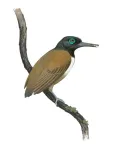New Zealand’s kākāpō developed different feather colors to evade predatory birds
Genome sequencing shows olive feather coloration evolved around the same time as two now-extinct predators
2024-09-10
(Press-News.org) Aotearoa New Zealand’s flightless parrot, the kākāpō, evolved two different color types to potentially help them avoid detection by a now-extinct apex predator, Lara Urban at Helmholtz AI, Germany and colleagues from the Aotearoa New Zealand Department of Conservation and the Māori iwi Ngāi Tahu, report in the open-access journal PLOS Biology, publishing September 10th.
The kākāpō (Strigops habroptilus) is a nocturnal, flightless parrot endemic to New Zealand. It experienced severe population declines after European settlers introduced new predators. By 1995 there were just 51 individuals left, but intense conservation efforts have helped the species rebound to around 250 birds. Kākāpō come in one of two colors — green or olive — which occur in roughly equal proportions.
To understand how this color variation evolved and why it was maintained despite population declines, researchers analyzed genome sequence data for 168 individuals, representing nearly all living kākāpō at the time of sequencing. They identified two genetic variants that together explain color variation across all the kākāpō they studied. Scanning electron microscopy showed that green and olive feathers reflect slightly different wavelengths of light because of differences in their microscopic structure. The researchers estimate that olive coloration first appeared around 1.93 million years ago, coinciding with the evolution of two predatory birds: Haast's eagle and Eyles' harrier. Computer simulations suggest that whichever color was rarer would have been less likely to be detected by predators, explaining why both colors persisted in the kākāpō population over time.
The results suggest that kākāpō coloration evolved due to pressure from apex predators that hunted by sight. This variation has remained even after the predators went extinct, around 600 years ago. The authors argue that understanding the origins of kākāpō coloration might have relevance to the conservation of this critically endangered species. They show that without intervention, kākāpō color variation could be lost within just 30 generations, but it would be unlikely to negatively impact the species today.
Co-author and conservationist Andrew Digby adds, “By using a comprehensive genomic library for the species, we have explained how the current colour morphs of kākāpō might be a result of pressure from extinct predators. Using genomics to understand the current significance of such characteristics is important as we seek to restore the mauri (life force) of kākāpō by reducing intensive management and returning them to their former habitats.”
#####
In your coverage, please use this URL to provide access to the freely available paper in PLOS Biology: http://journals.plos.org/plosbiology/article?id=10.1371/journal.pbio.3002755
Citation: Urban L, Santure AW, Uddstrom L, Digby A, Vercoe D, Eason D, et al. (2024) The genetic basis of the kākāpō structural color polymorphism suggests balancing selection by an extinct apex predator. PLoS Biol 22(9): e3002755. https://doi.org/10.1371/journal.pbio.3002755
Author Countries: Germany, New Zealand, United Kingdom
Funding: see manuscript
END
[Attachments] See images for this press release:

ELSE PRESS RELEASES FROM THIS DATE:
2024-09-10
Embargoed until Tuesday September 10 at 19:00 (BST)
Pregnant women who have limited access to affordable, nutritious, and healthy foods have a higher chance of developing both physical and mental health problems.
New research from Newcastle University has found that women who are what is termed “food insecure” are up to four times more likely to have poor mental health - such as stress, anxiety, and depression - than those who don’t struggle to afford or access food.
The mums-to-be are also at increased risk of obesity, developing diabetes during their pregnancy and dental problems, the two studies published ...
2024-09-10
Humans, livestock and companion animals benefit from virus-based vaccines and gene therapies, but crops do not. This paradox is highlighted by an international research group led by the Institute of Molecular and Cellular Biology of Plants (IBMCP) within the Spanish National Research Council (CSIC), in an article published in the prestigious journal Nature Reviews Bioengineering. The study proposes a roadmap to use attenuated viruses to enhance performance of crops, making them more resistant to extreme and changing climate ...
2024-09-10
About The Study: In 2023, all 3 payer markets (commercial insurance, Medicare Part D, and Medicaid managed care) for pharmacy benefit manager (PBM) services were highly concentrated, but concentration varied and was highest in Medicare Part D. While CVS Caremark held the dominant share in all 3 payer markets, each of the PBMs appeared focused on a different payer: Express Script’s largest share was in the commercial market, while Optum Rx’s and CVS Caremark’s were in Medicare Part D and Medicaid ...
2024-09-10
New research published in NEJM and presented at this year’s Annual Meeting of the European Association for the Study of Diabetes (EASD) in Madrid (9-13 Sept) shows that a new class of insulin that is injected once a week is as effective as daily insulin injections for effective and safe blood sugar management in patients with type 2 diabetes. The study is by Dr Carol Wysham, MultiCare Rockwood Center for Diabetes and Endocrinology, Spokane, WA, USA, and colleagues.
When patients with type 2 diabetes find their oral medications alone can no longer control their blood sugar, insulin therapy is added and injection frequency (having daily injections) is among the main factors that can contribute ...
2024-09-10
New research published in The Lancet and presented at this year’s Annual Meeting of the European Association for the Study of Diabetes (EASD) in Madrid (9-13 Sept) shows that a new class of insulin that only needs to be injected once weekly is as effective as daily insulin injections for effective blood sugar management in patients with type 1 diabetes. However, higher rates of hypoglycaemia using the new class means vigilance is needed for dose initiation and optimisation. The study is by Dr Richard M Bergenstal, ...
2024-09-10
RIVERSIDE, Calif. -- When they become fathers, men who have an unhealthy, high-cholesterol diet can cause increased risk of cardiovascular disease, or CVD, in their daughters, a University of California, Riverside-led mouse study has found.
The research, published in the journal JCI Insight, is the first to demonstrate this result seen only in female offspring.
CVD, the leading cause of death globally, is a group of disorders that affects the heart and blood vessels. Hypertension (high blood pressure) is a leading risk factor ...
2024-09-10
“For the first time, the present study revealed a critical role for protein palmitoylation in the development of a DNA damage-induced senescence phenotype.”
BUFFALO, NY- September 10, 2024 – A new research paper was published in Aging (listed by MEDLINE/PubMed as "Aging (Albany NY)" and "Aging-US" by Web of Science), Volume 16, Issue 16 on August 23, 2024, entitled, “2-Bromopalmitate treatment attenuates senescence phenotype in human adult cells - possible role of palmitoylation.”
As ...
2024-09-10
For paleontologists who study animals that lived long ago, fossilized remains tell only part of the story of an animal’s life. While a well-preserved skeleton can provide hints at what an ancient animal ate or how it moved, irrefutable proof of these behaviors is hard to come by. But sometimes, scientists luck out with extraordinary fossils that preserve something beyond the animal’s body. Case in point: in a new study published in the journal Current Biology, researchers found fossilized seeds in the stomachs of one of the earliest birds. This discovery shows that these birds were eating ...
2024-09-10
In a new study published in JAMA Network Open, researchers at Thomas Jefferson University have developed a novel screening tool to measure digital health readiness, which will be critical in addressing barriers to telehealth adoption among diverse patient populations.
The COVID-19 pandemic facilitated many rapid changes in healthcare, including a shift to using telehealth services across the U.S. instead of traditional in-person doctor’s visits. This ensured that patients continued to receive vital care, while only needing access to a mobile device or computer with a webcam. But just because a ...
2024-09-10
For more information, contact:
Nicole Fawcett, nfawcett@umich.edu
EMBARGOED for release at 11 a.m. Sept. 10, 2024
New law regulating out-of-pocket drug spending saves cancer patients more than $7,000 a year, study finds
The Inflation Reduction Act’s limit on Medicare Part D spending leads to significant savings for patients prescribed oral chemotherapy
ANN ARBOR, Michigan — As prescription oral chemotherapies have become a common form of cancer treatment, some patients were paying more than $10,000 a year for medications. A new study ...
LAST 30 PRESS RELEASES:
[Press-News.org] New Zealand’s kākāpō developed different feather colors to evade predatory birds
Genome sequencing shows olive feather coloration evolved around the same time as two now-extinct predators



